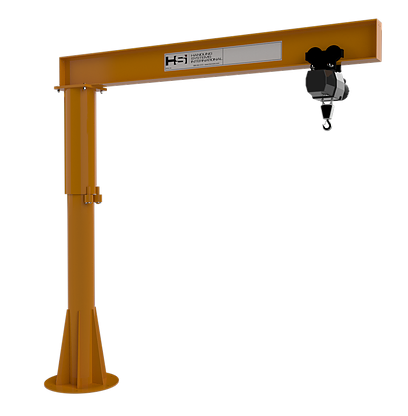Handling large material in a factory setting is often the starting point for many workplace injuries, frequently resulting in lower productivity and even resulting in permanent health conditions for the employee, in some cases the consiquence to the business results in court action which can carry hefty financial losses.
Luckily this can all be mitigated with the addition of safe handling solutions like lightweight crane systems and Jibs that take the repeative pressure out of handling those heavy loads in the workplace all day long. When combined with an electric hoist these cranes become extremely powerful tools in safety and effiicency.
.png) WHAT IS A JIB CRANE AND HOW CAN IT BE USED IN A FACTORY SETTING?
WHAT IS A JIB CRANE AND HOW CAN IT BE USED IN A FACTORY SETTING?
A Jib Crane is a single-pillar crane that consists of an upright column and an arm. This type of swing arm crane is often used in the manufacturing and construction industries, mostly to support the loading/unloading of larger cnc machines or tools. By using a jib in a factory setting, you can extend your reach and manipulate objects more easily than without one. It also helps to improve efficiency as it enables the operator to quickly place items at the desired location. Jib cranes come in different sizes, allowing you to choose one that best fits your production requirements and they can even be customized to suit your bespoke needs.
HOW DOES A JIB CRANE MAKE LOADING CNC MACHINES EASIER AND FASTER?
Jib cranes allow machine operators to handle large, heavy parts with great ease and efficiency. The arm rotates with typically a 270-360 degree angle to give maximum reach, lifting and loading materials in to CNC machines quickly and precisely. This saves valuable time on busy production floors, making your return on investment faster while keeping your costs low. Having several (or even just one) lightweight crane system can mitigate the need to interupt or even own an overhead gantry crane all together. For maximum efficiency many businesses operating lines of machinery that require heavy lifting choose to incorporate several units and even double-masted solutions that make use of a single post point which saves further on cost and installation interuptions as well as maximizing floor space.
WHAT ARE THE BENEFITS OF USING A JIB ARM TO LOAD CNC MACHINES?
Jib cranes are highly functional and beneficial pieces of equipment used in many production settings and have valuable applications when it comes to loading CNC machines. Installing a jib crane in your workplace can drastically reduce the risk of injury or accidents due to their reduced-weight load capabilities, as they provide easy access for workers to move heavy objects from place to place without strain or overexertion. Not only is this a great safety feature, but it also creates an atmosphere for increased worker job satisfaction because staff know that their employer values their safety and well-being. Additionally, these machines offer increased efficiency with higher output due to its speed and smoothness throughout the loading process; granting more time for workers to do other tasks, this can be further improved with the addition of a variable speed hoist. All together, utilizing a jib crane can be an effective game-changer in any production setting with its reduced injury potential, high levels of worker job satisfaction, and timely/efficient results.
HOW CAN YOU FIND THE RIGHT SWING ARM CRANE FOR YOUR FACTORY NEEDS?
Finding the right crane to fit your factory needs doesn't have to be a challenge. Start by measuring the overall height you need it to reach. Once you have that measurement, consider its span - or how far out it will reach. Make sure your jib crane can also clear any equipment within its span, such as low hanging lights or a celing or even another CNC machine that might be present in your space. If you are considering a light-duty crane, remind yourself that these should only be used for lightweight materials and small parts manipulation. Ultimately, take the time to measure correctly and assess any potential challenges associated with the installation of your new jib crane. You should also pay particular attention to the floor that the crane will be mounted on- will the crane be mounted on top of the existing floor (foundationless) or will there be an excavation needed in order to cast a base? If you're planning on laying a foundation for the system, be sure to consult us before hand to determine the correct size requirements for the concrete pad. It is also highly recommended you seek the advice of a structural engineer when planning this project.
As you can see these systems offer a lot of advantages for factories that need to load CNC machines quickly and efficiently. They are low cost, have a high ROI, and can improve worker satisfaction as well as safety by making the job easier and less strenuous on the body. You can find the right system for your factory needs by considering the above and by talking to one of our experience jib crane experts.



































